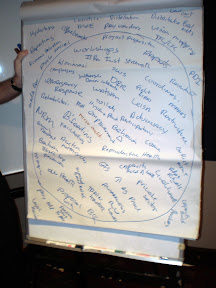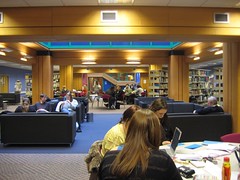OpenEd: Week 4
September 23, 2007, [MD]
 QUESTIONS:
What do these overviews of the field have in common? What do they
emphasize differently? What are the aims of the authors of each report?
Do you see a bias toward or against any ideas, organizations, or
approaches in any of the reports? Which report spoke the most clearly to
you, and why do you think it did? Based on where the field is now, and
these initial ideas about where it might go, what part of the open
education movement is most interesting to you? Why?
QUESTIONS:
What do these overviews of the field have in common? What do they
emphasize differently? What are the aims of the authors of each report?
Do you see a bias toward or against any ideas, organizations, or
approaches in any of the reports? Which report spoke the most clearly to
you, and why do you think it did? Based on where the field is now, and
these initial ideas about where it might go, what part of the open
education movement is most interesting to you? Why?
As mentioned below, I read these three reports one after another, and my impression was probably shaped both by exhaustion and the order in which they were read. There were very few concepts or projects that were new to me, which I guess means that I spend far too much time reading edubloggers, although as you can see in my notes below, I did pick up on some interesting concepts and frameworks. I got the most out of the first report, by CERI at OECD, which provided a good outline of the field, and some interesting thoughts on sustainability, motivation both by individual professors and institutions, and financial costs/benefits. Although the second reading, from OLCOS, did introduce the concept of moving from user-contributor to collaborator, and emphasized different ways of learning and teaching, in general I found the report tedious, poorly organized and very repetitive (granted, it was not the people at OLCOS’ fault that I had just read the CERI report hours before). Finally, the Atkins, Brown and Hammond paper for the Hewlett Foundation was nice in that it provided a very clear narrative arch, with a much more focused purpose than the two previous papers which were giving wide overviews of a field.
There
are many topics to pick up on in these papers, and I will choose only a
few. Open Courseware is the flagship of the OER movement, and MIT of
course, is the flagship of the OCW movement. However, when reading the
three different reports, and having spent substantial amounts of time on
the MIT OCW and other OCW sites, I keep wondering if there is something
I am missing… Granted that a few courses on MIT OCW offer video of whole
lectures, or audio, but most offer very minimal information/content: a
reading list (with mostly PDFs and books that are not freely available),
a course outline, a few essay questions, if we are lucky some lecture
notes in outline format - this is what is most often provided, and I
seriously question the utility of it. University of
Oslo has provided full course outlines for all their
courses online for years, and they have never claimed to be doing OCW,
in fact I have come to expect it, and was much annoyed when I realized
that at University of Toronto, one has to run
around attending classes that one might be interested in during the
first week, just to obtain course outlines.
Grand announcements are made about the impact of OCW, like for example this statement in the Atkins, Brown and Hammond paper: “The ten lead universities [in China] use several hundred MIT OCW in their teaching programs. This has had a major impact on Chinese education.” (p. 27) To say that something has had a major impact on Chinese education - spanning hundreds of universities which have very long histories, is a brazen statement - to say so without providing any source or evidence backing it up is poor science. I am very curious about the impact of OCW and how exactly people are using them, and at least MIT has been doing a lot of documentation work. I am planning to read both the OCW Case Studies, and the MIT OCW 2005 Final Evaluation Report to gain a better understanding of both what is actually happening, and how MIT views its role, and how it evaluates the success of the endeavor.
I also wonder about the cost. It was stated in one of the papers that it costs MIT \$25,000 to digitalize one course, and even with the best imagination, I cannot imagine how it would cost that much - especially for the sections that are just a few PDFs. I understand though, that one of the problems is having to clear a lot of the copyrighted material used in class - images and illustrations for example - this is a problem that the reports really brought home to me, and this is probably part of the reason why it’s costly for MIT, and why much of the material is not very exciting.
 So I
would love for MIT to provide full video of all their lectures - if not
for anything else, it wold be interesting to see how they teach, get
some ideas - and I can clearly see how this can be useful to many
people. However, if we are targeting self-taught learners (as opposed to
providing material that other teachers can assess and incorporate into
their classes), we need to really consider what their needs are. Indeed,
I have been thinking a lot about university pedagogics in general, and
trying to find a book that would explain to me the “dominant thinking”
of university pedagogics. I know a lot of it is historical hubris, but I
do hope that there would be some kind of educational theory that told us
that “So, you want to give a few hundred 19 year olds a deeper
understanding of American Civil Rights movements? Or the philosophy of
Spinoza? Here’s the best way - they should meet a professor for about
two hours a week, in a huge classroom, where they will mainly listen to
a powerpoint-driven talk given. Then they might meet a tutor for an hour
a week, in smaller groups, to discuss the topic, but mainly to ask about
what is on the exam, and finally they will write a term paper, and an
exam (multiple-choice of course).”
So I
would love for MIT to provide full video of all their lectures - if not
for anything else, it wold be interesting to see how they teach, get
some ideas - and I can clearly see how this can be useful to many
people. However, if we are targeting self-taught learners (as opposed to
providing material that other teachers can assess and incorporate into
their classes), we need to really consider what their needs are. Indeed,
I have been thinking a lot about university pedagogics in general, and
trying to find a book that would explain to me the “dominant thinking”
of university pedagogics. I know a lot of it is historical hubris, but I
do hope that there would be some kind of educational theory that told us
that “So, you want to give a few hundred 19 year olds a deeper
understanding of American Civil Rights movements? Or the philosophy of
Spinoza? Here’s the best way - they should meet a professor for about
two hours a week, in a huge classroom, where they will mainly listen to
a powerpoint-driven talk given. Then they might meet a tutor for an hour
a week, in smaller groups, to discuss the topic, but mainly to ask about
what is on the exam, and finally they will write a term paper, and an
exam (multiple-choice of course).”
The scenario listed above is what currently happens in most undergraduate classes - what I’d like to know is how much of that is just “we’ve always done it like that”, how much is “we’d love to do it radically different if we had the money”, and how much is “it’s actually a decent way of teaching them”. Having searched for books on the basics of pedagogics, most of what I can find are alternative pedagogics, radical pedagogics, criticisms of the current system. But somehow I would like to start with a pedagogical description of the current system - before we start tearing it to pieces. And I think this applies to online distance education as well - I would like to really understand the methods that people use, both in formal distance-ed classes, but more specifically self-motivated independent learners. I had a quick look at the case studies provided by MIT, but they go nowhere near deep enough, they merely describe the externals of a Professor of Architecture in Indonesia, who used some courses from MIT to brush up. I’d like to know, exactly what materials in those courses did he use, and how did he use them. What other materials would he have appreciated?
 That’s
not to say that institutions shouldn’t release their material freely.
Material that is produced anyway - lectures must be given and course
outlines created, might as well be posted online, and with some help
from work-study students to film the lectures, and cooperation from the
lecturers in providing PDFs, this ought not be prohibitively expensive.
Ideally then someone else could string together these elements into
courses -the playlist university, both making it available for people to
use whenever, and offering time-limited enrollment-like situations, like
this very course (which could easily have featured lectures by
professors at MIT School of Instructional Technology, if such a school
had existed, as part of the “curriculum”), which value-adds by giving
deadlines, a learning community, a shared process, and a mentor role. I
like what Connexions are doing with their concept of
lenses, and it would be great if
they expanded that to include playlist courses, both for asynchronous
use, but also for easy startup of time-based learning-community-based
courses to start and end (and perhaps add to the course content as part
of their process).
That’s
not to say that institutions shouldn’t release their material freely.
Material that is produced anyway - lectures must be given and course
outlines created, might as well be posted online, and with some help
from work-study students to film the lectures, and cooperation from the
lecturers in providing PDFs, this ought not be prohibitively expensive.
Ideally then someone else could string together these elements into
courses -the playlist university, both making it available for people to
use whenever, and offering time-limited enrollment-like situations, like
this very course (which could easily have featured lectures by
professors at MIT School of Instructional Technology, if such a school
had existed, as part of the “curriculum”), which value-adds by giving
deadlines, a learning community, a shared process, and a mentor role. I
like what Connexions are doing with their concept of
lenses, and it would be great if
they expanded that to include playlist courses, both for asynchronous
use, but also for easy startup of time-based learning-community-based
courses to start and end (and perhaps add to the course content as part
of their process).
As I mentioned, I could discuss many other aspects of these writings, but some of them have been menti0ned already, and I might add others during the coming week. In closing, I want to say that to me the most interesting directions are on one hand pedagogics, both basic pedagogics, distance-ed, collaborative and constructive learning, etc. I know there is a lot of material on this, and I’ll just have to sit down and read - when I can find the time. The second is the production and use among non-English speaking countries, especially but not by far limited to developing countries… localizing content and language, and perhaps finding innovative offline or hybrid ways of utilizing the information in teaching and learning.
Stian\ (thanks to ninefingers @ flickr for the Learn Checkers Fast photo, and jisc_infonet @ flickr for the library photo)
Stian Håklev September 23, 2007 Toronto, Canada comments powered by Disqus